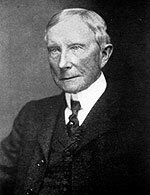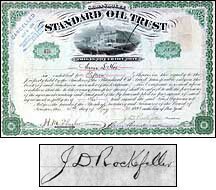The "Old Certificates Collectors' Club" offers a quarterly newsletter published every March, June, September and December. This informative bulletin features tips about collecting, historical insights, auction reviews, biographies of famous autograph and current scripophily news. For your benefit, we are releasing two sections of our current September 2000 Newsletter (Vol. 25) on the Internet. If you find this material interesting and would like to join the growing ranks of our Collectors' Club, click here for your membership application.
John Davidson Rockefeller (1839-1937)
 John D. Rockefeller was born on a farm at Richford, New York in the summer of 1839. His father, a trader in lumber, salt and other commodities, subsequently moved the family to Moravia (NY), where John first attended school. A year's further schooling at Oswego (NY) and two years of high school in Cleveland (OH), where the Rockefellers relocated in 1853, comprised his formal education. After three-and-a-half years with a Cleveland firm of commission merchants, the twenty-year-old Rockefeller established his first enterprise dealing in grain, hay, meats and miscellaneous goods.
John D. Rockefeller was born on a farm at Richford, New York in the summer of 1839. His father, a trader in lumber, salt and other commodities, subsequently moved the family to Moravia (NY), where John first attended school. A year's further schooling at Oswego (NY) and two years of high school in Cleveland (OH), where the Rockefellers relocated in 1853, comprised his formal education. After three-and-a-half years with a Cleveland firm of commission merchants, the twenty-year-old Rockefeller established his first enterprise dealing in grain, hay, meats and miscellaneous goods.
Sensing the commercial potential in the recent railroad linking of Cleveland to the burgeoning oil fields of northwestern Pennsylvania, Rockefeller joined in building a local refinery in 1863, which became the largest in Cleveland within two years. He bought out his partners in 1865 and, along with his brother William and Samuel Andrews, built a second refinery named the "Standard Works." William went to New York to develop the export and eastern trade while John enlisted Henry M. Flagler as a partner in 1867.
Following the latter's successful negotiation of lower freight rates, Rockefeller effected further economies by making his own barrels, building warehouses and acquiring fleets of lighters and tankers. Meticulous about details, he instituted a cost-accounting system accurate to the third decimal!
 In 1870, Rockefeller and a few associates officially incorporated the Standard Oil Company of Ohio. Now convinced that solvency depended on the end of "destructive" competition, he began to buy out his competitors and controlled nearly all the refineries in Cleveland by 1879. Ownership or control of pipelines was the next step, accompanied by the purchase or lease of oil-terminal facilities in New York and the beginning of an elaborate marketing system. Within seven years of its creation, Standard Oil dominated the American oil industry with a position close to monopoly and was about to conquer the foreign oil market.
In 1870, Rockefeller and a few associates officially incorporated the Standard Oil Company of Ohio. Now convinced that solvency depended on the end of "destructive" competition, he began to buy out his competitors and controlled nearly all the refineries in Cleveland by 1879. Ownership or control of pipelines was the next step, accompanied by the purchase or lease of oil-terminal facilities in New York and the beginning of an elaborate marketing system. Within seven years of its creation, Standard Oil dominated the American oil industry with a position close to monopoly and was about to conquer the foreign oil market.
By 1881, this organization of vast combination became increasingly perplexing as the original Ohio company, nucleus of the group, had no legal right to own property or stock outside Ohio. Rockefeller thus established a board of trustees which took over all stock and issued certificates of interest in the trust estates. The modern "trust" was born!
Although Rockefeller himself never intended to obtain absolute control of refining, Standard Oil's ruthless competitive practices led to the passage of the Sherman Antitrust Act by the U.S. Congress in 1890. Two years later, the Ohio Supreme Court held that the Standard Oil trust violated an Ohio law prohibiting monopolies. Rockefeller evaded the decision by dissolving the trust and transferring its properties to companies in other states, with interlocking directorates insuring that the same nine men controlled the operations of the affiliated companies.
A devout Baptist, Rockefeller turned his attention to charities and benevolence during the 1890s and devoted himself completely to philanthropy after 1897. His lifetime donations totaled more than $500,000,000 while his combined donations with his son, John D. Rockefeller Jr., exceeded $2,500,000,000 by 1955.
John D. Rockefeller Sr. gained a pre-eminent place as an organizing genius in both industry and philanthropy. Whether rationalizing the chaotic oil industry or exploring new fields in education, health and social welfare, he contributed a powerful initial impluse, intense application to detail, great penetration in solving difficult problems and a rare tact in welding together talented groups of men to implement his ideas. Although suffering from a bad public image, his passion was neither money-getting nor power-seeking, but a hatred of disorder and waste.
Wells Fargo established an office in Iowa Hill, near Sacramento, soon after the discovery of gold in the area in 1853.